[ HOME ]
Korea has a long tradition of making handmade paper which is called HANJI. The photos come from the city of Wonju's Hanji Festival which is held in October.
Korean Hanji
Korea had moveable type printing several hundred years before it's use in Europe. The type was used mainly to print Buddhist texts. Hanji was essential for this. The antique ones I saw were made of bronze.
Handmade Paper found extensive use in Korea. In homes, sturdy thick sheets were spread on the ondol heated floors and covered in varnish preventing smoke and carbon monoxide from coming into the room. It made a handsome golden tan coloured surface that was easy to keep clean. It is still done today in traditional homes and I have seen it in housing high rises. Vinyl flooring which is often used, still keeps the grid pattern of paper panels to suggest these traditional floors.
Traditional windows and screens were also covered in translucent paper. Japan adopted the same technique for the shoji screens. The wooden framework shape is quite different but the uses are similar.
Chinese style Korean brush painting and calligraphy uses traditional paper, as do the many craft items that were in common use such as lanterns, trays, countless designs of boxes, fans, small chests including sewing boxes, and small items of furniture such as low tables.

Paper Mulberry inner bark fibre. It is wildly time consuming to get this material separated from the outer bark. If any piece of outer bark is left, it makes a dark spot on the finished sheet.
Paper mulberry or DAK grows well in the sunny rocky slopes of Korea many mountains. It is prized for its long white fibres.
It's scientific name is Broussonetia kazinoki and it is commonly found in E. Asia. Link to growing information
It can be propagated in many ways including seeds, hard and soft wood cuttings, root cuttings and has been cloned as well.

Hibiscus root. The translation is somewhat uncertain. Wonju is not a tourist town and few people spoke English well enough to know the name of plants in English. After long discussion and pointing the consensus seems to be it's hibiscus. The roots makes a gluey viscous solution when soaked in water.
Later I looked up the name and the plant is Hibiscus Manihot Abelmoschus manihot

After picking the mulberry gets cooked and steamed briefly to loosen the bark which is pulled off. This bark which consists of the outer dark bark and the inner lighter coloured bark must be separated. The long strips of bark get scraped and the outer bark laboriously removed. The inner bark can be dried and kept at this point or it can be processed further to make paper.
The mulberry inner bark gets cooked in hot water with ashes added to make it alkaline. This helps dissolve the lignin and other resins. This cooking takes only a few hours. Once softened the bark gets rinsed then vigorously beaten. This vigorous beating on a stone using heavy clubs separates the fibres which have been softened by the cooking. This stone is about a metre across. This beating continues until eventually the fibres separate and the mixture starts looking pasty. The fibres remain long and thin. Two strong lean wiry men did this work and made it look effortless.
The writing on the stone says "Wonju Hanji Festival"

Pulp has been beaten (to a pulp so to speak) and is ready and can be used in the vat. The bowl behind has a gluey solution of the hibiscus roots. This material helps keep the mulberry fibres in suspension in the vat. This also keeps the fibres from clumping up and makes it possible to get nice even layers in the frame.
I'm told this glue is what allows Korean paper to separate into thin sheets without any felt between the sheets as Western papermaking technique require. Our language skills were not up to the task of clarifying exactly why a gooey material helps sheets come apart, but they do.
The amount of hibiscus goo that is added determines how the fibres stay in suspension and also how well and fast the water drains from the frame. More goo makes for slower draining.
I think the coming apart after pressing has more to do with how the fibres have aligned than the stickiness of the goo.
My experiment with a very closely related slime made from Okra (a member of the hibiscus family) shows that the slime has insignificant gluing properties but fabulous suspension capabilities. Link to my okra slime page Okra slime has been tried in traditional Japanese and Korean papermaking technique and has worked well.
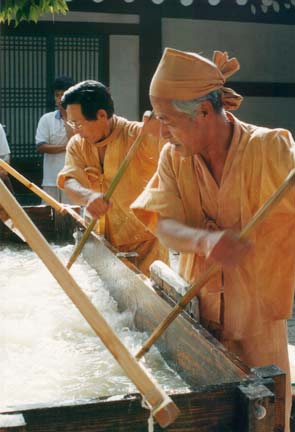
The mulberry paste is placed in a large wooden vat along with hibiscus root slime and it is agitated with great energy. 3 men with 4 feet long sticks whipped up the pulp. This was done when new pulp was added and frequently while the paper was being formed.
It's important to separate the fibres at first and subsequently to keep the fibres suspended so the fibres can be picked up evenly onto the forming screen. This process was surprisingly beautiful to watch. 3 men working in unison with easy smooth and strong motions. It looked effortless.
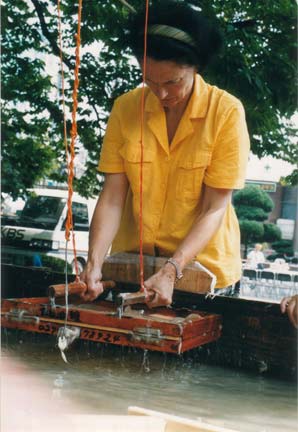
Several frames were suspended from a top beam above the pulp vat. Each had a fine bamboo mat which could be removed. The mat is a lot like mats made for shaping sushi rolls but finer. Depending on the size of paper being made different size frames could be substituted. The mat made a flexible screen.
The operator holds the frame by 2 handles and dips the frame into the vat of pulp. As the water drains the frame is gently dipped to one side and then the other. Again an economical precise motion that looks easy and takes a long time to master. Here I'm doing my best to get an even coating of fibres. The sideway motion aligns the fibres in an even coat as the water drains through the bamboo screen.
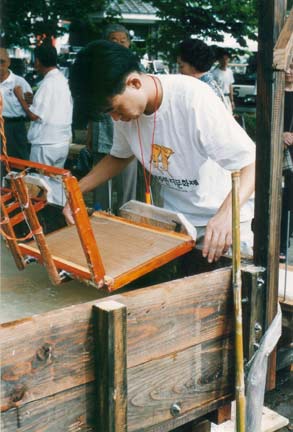
A thin coat of pulp has been deposited on the bamboo screen and water has dripped out. The thickness of the paper can be changed by modifying the pulp concentration somewhat or by dipping several times in the vat.
The hinged frame is hooked onto supports on the front of the vat and opened. The screen is carefully picked up. The paper is very fragile, nothing more than a gummy coating on the screen.

Each successive sheet is piled up carefully on top of the stack.
The screen is flexible. The papermaker aligns the screen to the bottom of the pile, then sort of rolls the screen across the pile transferring the layer of just screened pulp. At this point it is not even a sheet, just a very delicate layer of aligned fibres. As he does this he places a thin nylon line across one end of the stack of paper. This extends on both sides and is about one quarter inch from the edge. It looked like a strand of fishing line.
When a sufficiently thick pile is done at the end of the day, the whole pile is pressed. A wooden cover goes on top of the pile and a lever with a weight on the end pressed down and forced water out.
The pressing was done overnight. The next morning most of the water had drained and the pile had firmed up.
While still damp it went on to be separated and dried.

Another bit of magic. The craftsman (actually lady) took the end of the nylon thread and pulled it up giving it a bit of a flick that put the end on a stick. She had set up 3 small bamboo sticks which were placed just in front of the string. Pulling the string caused the paper to lift a bit and curl on the stick. She then twirled the stick a bit to grab the sheet and pulled it back.
In the photo she has 3 sticks each with a short roll of paper. She did a few more and then lifted each carefully to the dryer. Another skill that long experience made look easy.

She carefully picks up the sheet of paper using the stick to help support the sheet.
At this point the paper is still damp but quite robust and she was able to lift the now separate sheets.
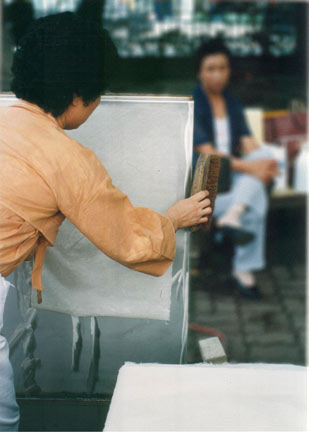
She placed the paper being supported by the stick against the stainless steel dryer and smoothed the rest of the sheet with a large soft brush. The dryer was made from 2 stainless steel sheets welded together and heated with a propane heater. It was not very hot and would not burn if touched. The surface was very smooth.
Driers are not always used. When working in their workshop papermakers might put the sheet out to dry naturally on smooth boards.
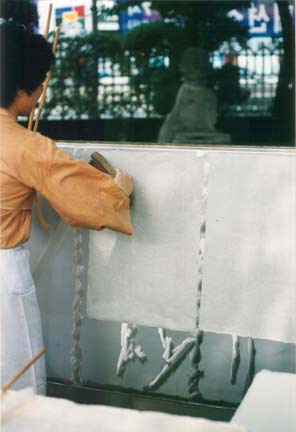
The dryer could accommodate quite large sheets or many small ones.
It took a few minutes for the paper to dry. She then carefully peeled one edge and it just came off with no problem.
Heated dryers are not always used. In the hanji festival display it is easier to dry the sheets than to let them naturally dry on wooden frames as is can also be done. Naturally dried paper is more prized and considered better. The paper being made was quite thin and very strong. The surface was smooth and almost shiny.
This very finely textured surface would have been ideal for either the block printing that was often used or for the actual moving type printing that had been developed a few hundread years before Gutenberg was printing his bibles.
They also explained that several sheets could be bonded to make thicker paper. I did not see this done but there were several antique boxes that used this method to make the thicker cardboard used.
Some Uses of Hanji Handmade Paper
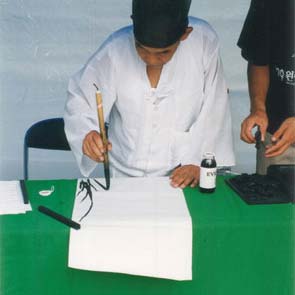

Korean Handmade paper being used for calligraphy and Chinese style brush painting. This is a master calligrapher and his apprentice.
Hanji Paper is superbly suited to printing. Both woodblocks and movable type printing has been done in Korea for centuries. It was in use long before Gutenberg "invented" movable type.
Here a buddhist text has been carved in a wooden plate and is being printed. The young man inked the plate using an ink pad and placed a sheet of Hanji on the design. He then padded the paper to transfer the ink.
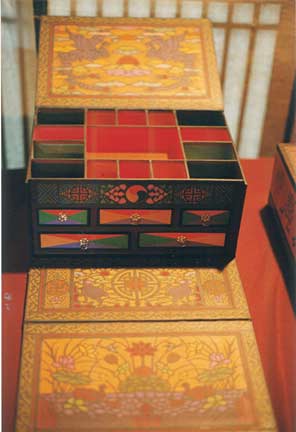

Intricate sewing box completely made of paper. Darker paper is cut and applied on top of traditional designs to gives a "stained glass look"
This method of making boxes, small tables and other household goods was widely used in the past.

Korean Handmade paper lantern and small table. These small tables are used to serve meals and refreshments. The people would be sitting on the floor on cushions. The floors were often heated using Ondol which made it very comfortable.
When I was in Korea, school kids were still being taught how to make these traditional objects.

Boxes in every shape and colour, small trays and open dishes
Koreans are not timid about using colours.
Traditional Hanji can still be bought but it is not cheap. There is also a large supply of modern machine made paper made to look like hanji. This is much less expensive.
Kits are now available. The cardboard forms are die cut and the user can assemble them and cover with favourite hanji pager. Here is a Youtube video on making a simple paper board accessories.
A sampling of quite sophisticated Hanji paper objects. Some very fine.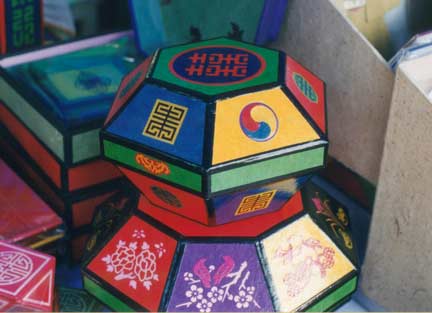
More boxes. The designs are cut out of contrasting paper and can take quite a lot of time to make.
Once the paper design are dry, the whole object often gets a coat of varnish. This makes it more waterproof and protects it from dirt.
Here is an article on Korean Paper Making from Cornell University.
Great video showing the different steps of traditional Korean paper making (with a few modern tools thrown in.)

Traditional door with paper covering. These can still be found in traditional buildings and in temples.
Sliding screens much like the Japanese shoji were in common use. When the paper gets damaged it is not difficult to glue a new sheet of paper on the framework.
This screen was being used as a window but they are also used as movable room divider.
[ HOME ]
emails:Christine
This web site reflects my personal ideas and doesn't represent anyone else's point of view.
Hugesavings 4 Inch Rubber Brayer Roller Ink Paint Block Tool for Printmaking, Printing, Scrapbooks, Wallpapers, Stamping, Gluing Application


[10 Pcs] Korean Traditional Mulberry Paper HanJi Including Real Materials Natural White Reed Flower 25.2" x 37.4"

Hanji: Everything You Need to Know about Traditional Korean Paper

The Classic Paper Making Kit by Wooden Deckle

Lonely Planet Korea (Travel Guide)

Learning Educational Paper Making Kit

Steel Bookbinding Papermaking Press Screw Press Flattening Machine

Speedball Deluxe Block Printing Kit

Broussonetia papyrifera - paper mulberry - 50 seeds

Article on Ondol Heating has a photo of a traditional ondol heated floor covered with Hanji paper.
Wikipedia article on Korean Paper.
Polistini sells Hanji as a conservation paper because hanji is strong and ph neutral.
